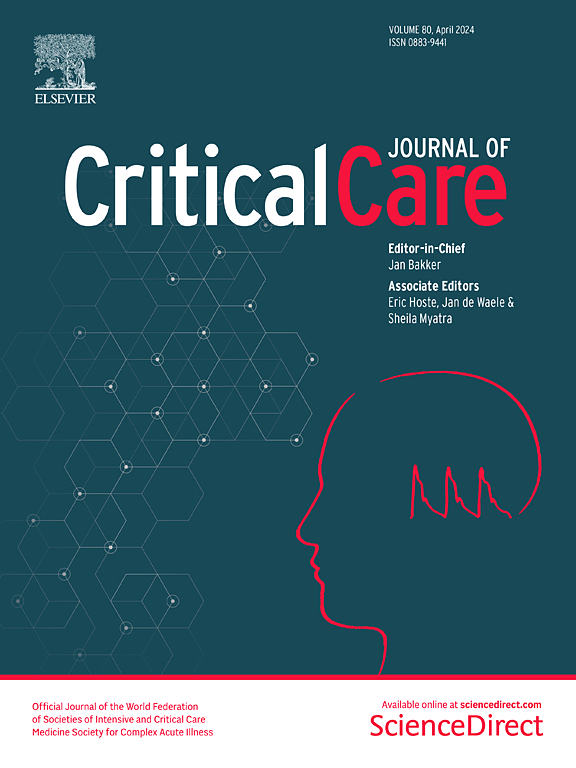Haloperidol in treating delirium, reducing mortality, and preventing delirium occurrence: Bayesian and frequentist meta-analyses
IF 8.8
1区 医学
Q1 CRITICAL CARE MEDICINE
引用次数: 0
Abstract
Although haloperidol is commonly used to treat or prevent delirium in intensive care unit (ICU) patients, the evidence remains inconclusive. This study aimed to comprehensively evaluate the efficacy and safety of haloperidol for delirium treatment and prevention in ICU patients. We searched MEDLINE, the cochrane central register of controlled trials, EMBASE, ClinicalTrial.gov, and PubMed without language restrictions from database inception to June 27, 2024. We included double-blind randomized controlled trials (RCTs) on haloperidol versus placebo for treating and preventing delirium in adult ICU patients. In addition to frequentist analyses, Bayesian analysis was used to calculate the posterior probabilities of any benefit/harm and clinically important benefit/harm (CIB/CIH). The primary outcomes for delirium treatment were all-cause mortality and serious adverse events (SAEs). For delirium prevention, the primary outcomes included incident delirium, all-cause mortality, and SAEs. The secondary outcomes for efficacy were delirium-or coma-free days, ventilator-free days, length of stay in ICU, length of stay in hospital, and rescue benzodiazepine use. The secondary outcomes for safety were QTc prolongation and extrapyramidal syndrome. We included seven RCTs on delirium treatment (n = 1767) and five on delirium prevention (n = 2509). The Bayesian analysis showed that, compared to placebo for delirium treatment, haloperidol had a 68% probability of achieving CIB (defined as risk difference [RD] < −0.02) in reducing all-cause mortality, a 2% probability of achieving CIH (RD > 0.02) in causing SAEs, and a 78% probability of achieving CIB (RD < −0.02) in reducing the need for rescue benzodiazepine use. The probabilities of haloperidol causing CIH (RD > 0.02) across all other safety outcomes were low (all < 50%). In frequentist analysis on delirium treatment, the pooled estimated RD for haloperidol compared to placebo was -0.05 (−0.09, −0.00; I2 = 0%) for rescue benzodiazepine use. In Bayesian analysis on delirium prevention, haloperidol had a 12% probability of achieving CIB in all-cause mortality, a 34% probability of achieving CIB in delirium incidence, and a 0% probability of achieving CIB in SAEs. Importantly, haloperidol had a 65% probability of causing CIH (risk ratio > 1.1) for QTc prolongation, while the posterior probabilities of achieving CIB across all efficacy outcomes were low (all < 50%). In frequentist analysis on delirium prevention, all primary and secondary outcomes were not statistically significant in frequentist analysis. Our study supported the use of haloperidol for delirium treatment in adult ICU patients, but not for delirium prevention.氟哌啶醇治疗谵妄,降低死亡率,预防谵妄发生:贝叶斯和频率元分析
虽然氟哌啶醇通常用于治疗或预防重症监护病房(ICU)患者的谵妄,但证据仍不确定。本研究旨在综合评价氟哌啶醇治疗和预防ICU患者谵妄的疗效和安全性。我们检索了MEDLINE、cochrane对照试验中心注册库、EMBASE、ClinicalTrial.gov和PubMed,没有语言限制,从数据库建立到2024年6月27日。我们纳入了氟哌啶醇与安慰剂治疗和预防成人ICU患者谵妄的双盲随机对照试验(rct)。除频率分析外,贝叶斯分析用于计算任何获益/危害和临床重要获益/危害(CIB/CIH)的后验概率。谵妄治疗的主要结局是全因死亡率和严重不良事件(SAEs)。对于谵妄预防,主要结局包括谵妄事件、全因死亡率和SAEs。次要疗效指标为无谵妄或昏迷天数、无呼吸机天数、ICU住院时间、住院时间和抢救苯二氮卓类药物使用情况。安全性的次要结局是QTc延长和锥体外系综合征。我们纳入了7项关于谵妄治疗的rct (n = 1767)和5项关于谵妄预防的rct (n = 2509)。贝叶斯分析显示,与安慰剂治疗谵妄相比,氟哌啶醇在引起SAEs方面达到CIB的概率为68%(定义为风险差[RD] 0.02),在所有其他安全性结局中达到CIB的概率为78% (RD 0.02),而在QTc延长方面达到CIB的后验概率较低(均为1.1),而在所有疗效结局中达到CIB的后验概率较低(均< 50%)。在谵妄预防的频率分析中,所有主要和次要结果在频率分析中均无统计学意义。我们的研究支持氟哌啶醇用于成人ICU患者谵妄治疗,但不用于谵妄预防。
本文章由计算机程序翻译,如有差异,请以英文原文为准。
求助全文
约1分钟内获得全文
求助全文
来源期刊

Critical Care
医学-危重病医学
CiteScore
20.60
自引率
3.30%
发文量
348
审稿时长
1.5 months
期刊介绍:
Critical Care is an esteemed international medical journal that undergoes a rigorous peer-review process to maintain its high quality standards. Its primary objective is to enhance the healthcare services offered to critically ill patients. To achieve this, the journal focuses on gathering, exchanging, disseminating, and endorsing evidence-based information that is highly relevant to intensivists. By doing so, Critical Care seeks to provide a thorough and inclusive examination of the intensive care field.
 求助内容:
求助内容: 应助结果提醒方式:
应助结果提醒方式:


